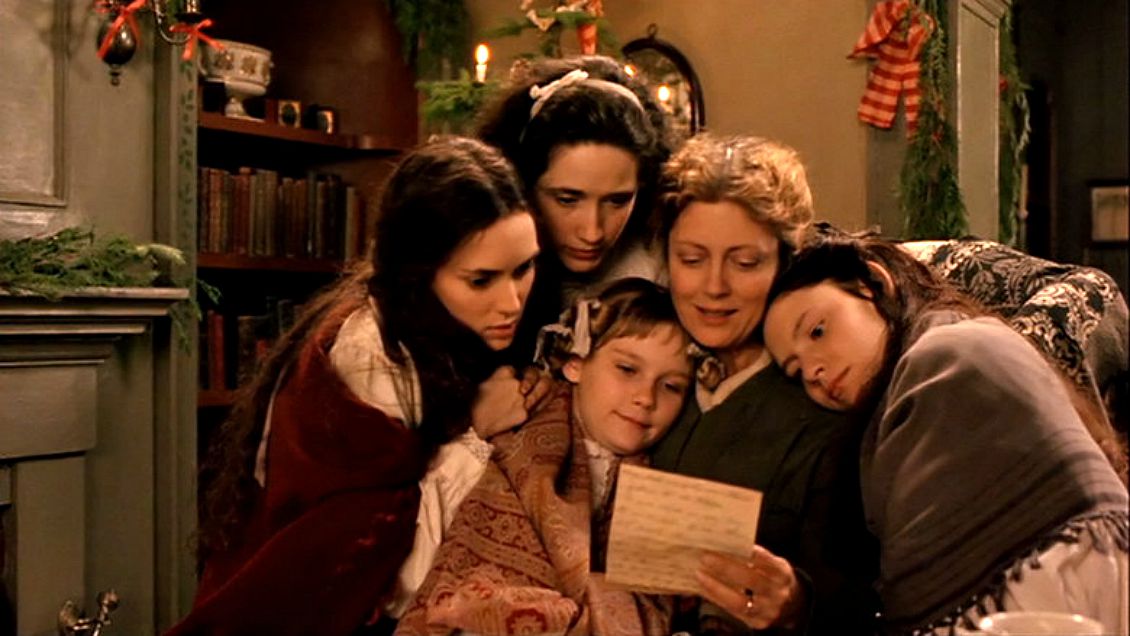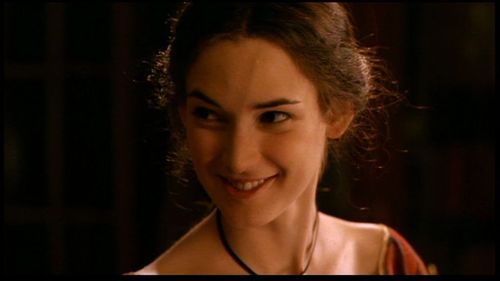This guest post written by Allyson Johnson appears as part of our theme week on Sisterhood.
Few films have shaped my life so far in the way that Gillian Armstrong’s adaptation of Louisa May Alcott’s Little Women did. Being one of the very first films I remember watching and seeing Jo (Winona Ryder) and her bookish ways, brazen behavior, and “unconventional” beauty created a role model for me. She was someone I identified with and also strived to be. Our perception of this film (and book) is expected to change as we grow older.
Despite the overabundance of affection I hold for Christian Bale’s Teddy, as an adult, I understand why Jo chose not to pursue him romantically. But that heartbreak of a lessened friendship stings greater. The appeal and natural oozing chemistry between her and Bhaer (Gabriel Byrne) is more tangible to a 25-year-old than a 10-year-old who would see Amy and Teddy’s marriage as a deception. Now, there’s the sorrow of their union along with the joy of Amy getting her girlhood crush — who promised her he’d “kiss her before she died” — and Teddy becoming a member of the March family after all that time.
However, the clearest, most poignant development that comes through growing with the films is how ultimately, the love story between Jo and Bhaer and the unrequited love story between Jo and Teddy mean little juxtaposed to the love shared between the four sisters. They are one another’s hearts and souls, evident as Jo writes her novel at the end of the film. It’s her sisters’ words that fill her memories and come pouring out from her fingertips, to her pen and onto the page, forever marked in ink with the spirits of the women who helped frame who she grew to be.
My idolization of Jo was never much of a surprise, from her tomboy nature to her passion for storytelling. Her burnt dress, her hair being her “one beauty,” her conflicting feelings over growing older and carving out a place for herself in the world, it all struck that resonating chord where I could see pieces of myself for better and worse. She is the character I first truly latched onto and that affection never faded, instead growing over time as her flaws became more apparent and more relatable too. She was human and beautifully imperfect; growing older is learning how to love that imperfection in both yourself and in others.
What has taken longer has been my appreciation for the rest of the March clan, the sisters for the most part. In my childhood, Beth (Claire Danes) had been most notable for her death and how it affected Jo. The scene where she’s gifted a piano never failed to drive me to tears but Beth, as she admits herself, has never been the one that stood out. She was there to listen and encourage; to be Jo’s best friend and confidant. She saw herself as someone who was never really meant to lead but follows in her mother’s and sisters’ footsteps happily. As we grow, we see what made her so integral — beyond her obvious generosity and kindness. Her soul was sweet, to the point that even in her last, dying breaths she comforts Jo, saying that for once it will be her turn to go first before the wind comes, knocking the windows from their latch, and sweeping Beth’s spirit along with it, leaving behind all the lives she has touched. The empathy Beth possessed and the means in which she delivered upon it are highlighted once we’re past the point in our adolescence when selfishness can be somewhat second nature.
Meg (Trini Alvarado) was an even trickier character to relate to because I (as I’m sure many of you did too) saw her as Jo did at the start: someone caught up in what was expected of her rather than someone who proudly owned her identity. It was and is an immature point of view to take on such a world-weary character. As the eldest sister, she’s played second-in-command for her mother for so long, so how do we begrudge her a night of frivolity — of senseless fun? Meg, in the most rudimentary sense of the world, leads the simplest life. She’s married and has children with a good, dependable husband. But one can’t help and wonder what a film told from her perspective might entail as she watches her sisters, one by one, depart from home.
And then there’s little old Amy (Kirsten Dunst and Samantha Mathis). Amy, who has taken me the longest to come around to, but now is a character who I hold dearly with as much adoration as I do for Jo, but in a juxtaposed manner. Curious, clever, and yes, sometimes selfish, as so often little kids are, she is so often poised as Jo’s opposite despite so many similarities. Both artistic but Amy’s painting lends itself more to what is expected out of a woman of that time, as opposed to Jo and her writing. Where Jo bucks at conformity, Amy desperately wants to fit in.
As a child, it was so easy to see Amy burning Jo’s book and label it a heinous crime; a moment where as an eldest sister, seeing a younger sister get away with something so purposefully spiteful was damn near irredeemable. As I grew, I saw the desperation in the act, the malice in Jo’s words towards Amy, and how the two should have been allowed lost time to make up, if their words to one another after Amy falls into a frozen lake mean anything. Amy looks like a doll, is naturally considered beautiful, and falls in line with latest trends, even if they’re as silly as limes. But she’s young and impulsive, and there is something so stiflingly sweet natured about her that allows for her more selfish acts to be forgiven. It just took me growing out of my tweens and teens to find those traits endearing rather than aggravating. It was never Amy’s fault that she was favored, it was society’s and how and who they deemed to be women of value. Amy simply existed in a world where the rules of who women should be and how they should behave were already dictated. Learning that crucial element brings a whole new clarity to Amy and her dynamic with Jo. Amy never tried to beat Jo at anything.
Little Women, both in novelization and cinematic form, is a remarkable story and one that I predict I’ll hold dear to me for the rest of my life; so embedded is Jo in my skin that I can’t fathom a time where I won’t see her influence. When I was younger, I thought that it was Jo’s writing abilities, her understanding of what it meant to be set apart that made her so appealing and a character to be reckoned with. However, I now understand that it’s her relationships with her sisters, her empathy with Beth, reliance on Meg, and protective nature of Amy that makes her so wonderfully tangible. Her sisters and their bond inform her being; it’s only natural that they should also allow her to shine as brightly as she does.
See also at Bitch Flicks: Hellraisers in Hoop Skirts: Gillian Armstrong’s Proudly Feminist ‘Little Women’; Jo March’s Gender Identity as Seen Through Different Gazes
Allyson Johnson is a 20-something living in the Boston area. She’s the Film Editor for TheYoungFolks.com and her writing can also be found at The Mary Sue and Cambridge Day. Follow her on Twitter for daily ramblings, feminist rants, and TV chat @AllysonAJ.










